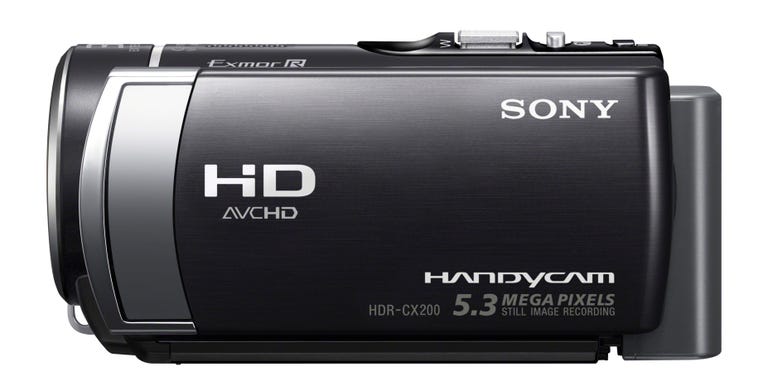 Why You Can Trust CNET
Why You Can Trust CNET Sony Handycam HDR-CX200 review: Sony Handycam HDR-CX200
Sony Handycam HDR-CX200
Sony's trio of entry-level camcorders -- the Handycam HDR-CX190, CX200 and CX210 -- seem amazingly, aggressively priced. But they're priced like standard-definition camcorders because they use SD-level components to produce video in HD format but not HD quality. Sony's not alone in this: both Canon and Panasonic play the same game to various degrees with their entry-level models. All of them use low-resolution sensors and interpolate the video up to HD resolution. In this case, Sony actually is using a sensor that's even smaller and lower-resolution than the 2-year-old CX110.
The Good
The Bad
The Bottom Line
The three camcorders differ from each other in a few ways. The CX200 and CX210 incorporate touch screens; the CX190 has a small joystick and playback button on the LCD bezel for operation. In addition, the CX210 has 8GB of internal memory -- keep in mind when comparing prices between the CX200 and CX210 that an 8GB flash card costs less than $10. This review is based on testing of the CX190. (There's also a version of the camcorder with a built-in projector, the PJ200.)
As far as I can tell, the video quality doesn't look any worse than predecessors like the CX130, which many folks consider acceptable. If you view your video scaled down and played on a computer, or like to shoot close-ups, which usually deliver the best results for both cameras and camcorders, it looks good. But for typical tourist and home-video type shooting of middle distances and viewed at actual size or on a large-screen TV, I found it extremely soft and mushy. The combination of sensor and optics seem prone to fringing, and can produce an overall purplish cast on the video rather than just on edges. In low light -- say, early dusk -- it's even softer and quite noisy. The audio is typical for its class; a little too bright-sounding, but the mic picks up the sounds you want.

Stills look pretty bad -- soft and overprocessed. Many camera phones are better. (Unsurprising given that Sony's "5.3-megapixel" photos are actually 1.3-megapixel photos bloated up for specsmanship.) Part of the problem is that you can't pick a focus area, at least on the CX190. You just have to point and pray. The CX200 and CX210 both have spot focus and exposure via the touch screen.
On the upside, the performance isn't bad, though the battery seems to run down a little faster than I'd like -- it lasts about an hour. The LCD actually remains quite visible in bright sunlight and the camcorder focuses relatively quickly and accurately. The image stabilization works well for about three quarters of the zoom range; I think part of the problem is that the camcorder is a little too light and harder to keep steady than some.
Of course, its compact, light design is one of the attractions of the camcorder, though it also makes it feel quite plasticky and flimsy. It fits comfortably in a roomy jacket pocket or bag. The design is also typical of these entry-level models, with a zoom switch, photo shutter and mode (movie/still) button on top and a record button in the back for thumb operation. A manual switch opens and closes the lens cover.
There's a short, captive USB cable that slides into the hand strap, and you can use it for charging, though the camcorder comes with a traditional AC adapter charger as well. Beneath the strap there's a covered recess with the SD card slot and an AV-out connector. The recess beneath the LCD panel contains Mini-HDMI and Mini-USB connectors, and there's a joystick and play button on the LCD bezel. Note that there's no power button. That gets really annoying; when the camcorder goes into sleep mode, you have to close and open the LCD in order to wake it up. It's doubly annoying when it goes to sleep while you've got it connected to a TV, since you have to remove the HDMI cable in order to close the panel and wake it up.
|
Canon Vixia HF R300/ R30/ R32 |
Panasonic HC- V100/ V100M |
Sony Handycam HDR- CX190/ CX200/ CX210 | |
| Sensor (effective video resolution) | 2.07- 1.04 megapixel CMOS (varies with IS) | 1.3 - 1.1-megapixel CMOS (varies with IS) | 1.31 megapixels |
| 1/4.85 inch | 1/5.8 inch | 1/5.8-inch | |
| Lens | 32x f1.8-4.5 38.5 - 1232mm (varies with IS) | 34x f1.8-4 32.5 - 1205.7mm | 25x f1.8-3.2 36 - 900mm |
| Closest focus (inches) | 0.4 | n/a | 0.4 |
| Min illumination (lux) | recommended: 100 standard: 5 low light: 0.4 | standard: 1400 low light: 4 Color Night View: 1 | recommended: n/a standard: 11 low light: 3 |
EVF | None | None | None |
| LCD | 3-inch 230,000 dots touch screen | 2.7-inch 230,400 dots | 2.7-inch 230,000 pixels/ 2.7-inch 230,000-pixel touch screen/ 2.7-inch 230,000-pixel touch screen |
| Primary media | 1 x SDXC/ 8GB, 1 x SDXC/ 32GB; 1 x SDXC | 1 x SDXC/ 8GB internal, 1 x SDXC | 1 x SDXC/ 1 x SDXC/ 8GB internal, 1 x SDXC |
| HD recording (best quality) | AVCHD: 1080/60i/30PF @ 24Mbps | AVCHD:
1080/60i @ 17Mbps | AVCHD: 1080/60i @ 24Mbps |
| Manual shutter speed | No | No | No |
| Manual iris | No | Yes | No |
| Accessory shoe | No | No | No |
| Audio | 2 channels; mic, headphone jacks | 2 channels | 2 channels |
| Body dimensions (WHD, inches) | 2.1 x 2.2 x 4.5 | 2.0 x 2.3 x 4.4 | 2.1 x 2.3 x 4.5 |
| Operating weight (pounds) | 9.9 (est) | 6.4 (est) | 7.4 |
| Mfr. Price | $349.99/ $449.99/ $549.99/ | $319.99/ $369.99 | $259.99/ $339.99/ $329.99 |
| Ship date | March 2012 | April 2012 | February 2012 |
Though it has some basic manual operation, like white balance and exposure compensation, the camcorder really is designed to be used in full auto. Getting to the manual settings means jumping into the menus, which are organized logically but still require some navigation that interrupts the actual shooting. Although I haven't used the touch screens on the slightly higher end models, historically 2.7-inch camcorder displays make for very cramped touch screens.
Conclusion
If you find this kind of video quality OK and you're really budget-minded, then I'd consider the Panasonic HDC-SD40 instead. It's an older model that delivers similarly lackluster video, but provides manual controls and you can find it for less than $200. If you've got your heart set on one of these Sonys, go with whichever you can find the cheapest. But if you want real HD-quality video, you still have to spend at least $500.


